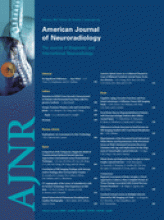Abstract
BACKGROUND AND PURPOSE: The cross-sectional rate of whole-brain N-acetylaspartate (NAA, a neuronal cell marker) loss in clinically similar relapsing-remitting multiple sclerosis (RRMS) patients has recently been shown to fall into 3 distinct decline rate strata. Our goal was to test the reproducibility of this observation in a new cohort of RRMS patients.
MATERIALS AND METHODS: Sixteen serial patients (12 women, 4 men, median age 38 [27–55] years) with clinically definite RRMS for an average of 5 (0.3–18) years’ disease duration and a mean Expanded Disability Status Score of 2.0 (0–6) were studied, once each. Their whole-brain NAA (WBNAA) amounts, obtained with proton MR spectroscopy, were divided by brain volumes (segmented from MR imaging) to yield concentrations suitable for cross-sectional comparisons.
RESULTS: Three distinct strata of cross-sectional NAA decline rates were found: −0.031, −0.32, and −1.71 mmol/L/y when disease duration was estimated from confirmed diagnosis, or −0.057, −0.20, and −1.38 mmol/L/y when measured from the first clinical symptom. These rates and their corresponding fractions of the study population were indistinguishable from those reported previously in a different group of 49 clinically similar (mean Expanded Disability Status Score also 2.0) RRMS patients.
CONCLUSION: Reproducing the previous cohort’s cross-sectional WBNAA decline characteristics in this new group of clinically similar RRMS patients indicates that 3 WBNAA loss strata may be a general attribute of MS. Consequently, WBNAA could serve as a surrogate marker for the global load of neuronal and axonal dysfunction and damage in this disease.
- Copyright © American Society of Neuroradiology












